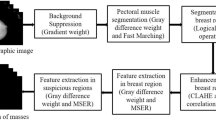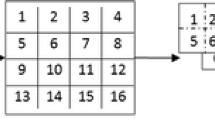Abstract
Detection of breast cancer masses in mammogram images is an essential step in any computer-aided system for breast cancer diagnosis. In this paper, we propose a novel technique for breast cancer masses detection in mammograms based on the feature matching of different regions using Maximally Stable Extremal Regions (MSER). Firstly, a pre-processing step is applied to the original mammogram image to produce an enhanced version of this image. Then, MSER regions are extracted from both the original image and its enhanced version using MSER detector. Finally, feature matching process is applied between these regions to detect the mass area. The proposed algorithm has been tested on a collected set of 300 mammogram images containing abnormalities (i.e. benign and malignant masses) from four different databases. The proposed algorithm is able to accurately detect locations of masses with an accuracy of 95%. There aren’t any processing steps for pectoral muscle removal, this results in reducing the processing time. The average time taken by the proposed method to process one mammogram image is 0.14 s. The proposed method is fully automated and there is no need for user intervention or any readjustment. The proposed algorithm is robust against noise and it is not affected by the image quality, breast density category, or mass nature. The results show that the proposed algorithm has higher accuracy than the state of the art approaches.
















Similar content being viewed by others
References
Al-antari MA, Al-masni MA, Park SU et al (2018) An automatic computer-aided diagnosis system for breast cancer in digital mammograms via deep belief network. J Med Biol Eng 38(3):443–456
Anitha J, Dinesh Peter J, Immanuel Alex Pandian S (2017) A dual stage adaptive thresholding (DuSAT) for automatic mass detection in mammograms. Comput Methods Prog Biomed 138:93–104
Bay H, Ess A, Tuytelaars T, Van Gool L (2008) SURF:speeded up robust features. Comp Vision Image Underst (CVIU) 110(3):346–359
Cordeiroa FR, Santos WP, Silva-Filho AG (2016) An adaptive semi-supervised fuzzy GrowCut algorithm to segment masses of regions of interest of mammographic images. Appl Soft Comput 46:613–628
Deshmukh J, Bhosle U (2017) SURF features based classifiers for mammogram classification. In: International conference on wireless communications, signal processing and networking (WiSPNET), Chennai. IEEE, pp 134–139
Elsawy N, Sayed MS, Farag F (2017) Selective energy-based histogram equalization for mammograms. In: Proc. of the Japan-Africa conference on electronics. Communications, and computers (JAC-ECC). Alexandria. Egypt, pp 123–126
Hassan SA, Sayed MS, Farag F (2014) Segmentation of breast Cancer lesion in digitized mammogram images. In: Cairo international biomedical engineering conference. IEEE, pp 103–106
Heath M, Bowyer K, Kopans D et al (2001) The digital database for screening mammography. In: Yaffe MJ (ed) Proceedings of the fifth international workshop on digital mammography. Medical Physics Publishing, pp 212–218. http://marathon.csee.usf.edu/Mammography/Database.html. Accessed May 2018
Jasmin MR, Soorya P (2015) Cancer mass detection from mammogram based on enhanced feature extraction method. International Journal Of Engineering Research & Technology (IJERT) NCICN 3(13)
Lee RS, Gimenez F, Hoogi A, Rubin D (2016) Curated breast imaging subset of DDSM. The Cancer Imaging Archive. https://wiki.cancerimagingarchive.net/display/Public/CBIS-DDSM. Accessed May 2018
Lowe DG (2004) Distinctive image features from scale-invariant keypoints. Int J Comput Vis 60(2):91–110
Makandar A, Halalli B (2016) Threshold based segmentation technique for mass detection in mammography. J Comput 11(6):472–478
Matos CEF, Souza JC, Diniz JOB et al (2018) Diagnosis of breast tissue in mammography images based local feature descriptors. Multimed Tools Appl:1–26
Moreira IC, Amaral I, Domingues I et al (2012) Inbreast: toward a full-field digital mammographic database. Acad Radiol 19(2):236–248
Mustafa M, Najwa H, Rashid O, Abdullah NRH et al (2017) Mammography image segmentation: Chan-Vese active contour and localised active contour approach. Indonesian Journal of Electrical Engineering and Computer Science (IJEECS) 5(3):577–588
National Cancer Institute [online]. http://www.cancer.gov/cancertopics/types/breast. Accessed 22 June 2018
National Cancer Institute [online]. https://seer.cancer.gov/statfacts/html/breast.html. Accessed 22 June 2018
Neto OPS, Silva AC, Paiva AC, Gattass M (2017) Automatic mass detection in mammography images using particle swarm optimization and functional diversity indexes. Multimed Tools Appl 76(18):19263–19289
Nister D, Stewenius H (2008) Linear time maximally stable extremal regions. Lecture notes in computer science. 10th European conference on computer vision. Marseille. France. No. 5303, pp 183–196
Oliver A, Torrent A, Llado X et al (2010) Automatic diagnosisof masses by using level set segmentation and shapedescription. In: IEEE 20th international conference on pattern recognition (ICPR), pp 2528–2531
Pereira DC, Ramos RP, Zanchetta do Nascimento M (2014) Segmentation and detection of breast cancer in mammograms combining wavelet analysis and genetic algorithm. Comput Methods Prog Biomed 114(1):88–101
Pui S, Minoi JL (2018) Keypoint descriptors in SIFT and SURF for face feature extractions. In: Alfred R, Iida H, Ag. Ibrahim A, Lim Y (eds) Computational science and technology. ICCST 2017. Lecture notes in electrical engineering, vol 488. Springer, Singapore
Rahmati P, Adler A, Hamarneh G (2012) Mammography segmentation with maximum likelihood active contours. Med Image Anal 16:1167–1186
Rajkumar KK, Raju G (2015) Automated mammogram segmentation using seed point identification and modified region growing algorithm. British Journal of Applied Science & Technology (BJAST) 6(4):378–385
Rouhi R, Jafari M, Kasaei S et al (2015) Benign and malignant breast tumors classification based on region growing and CNN segmentation. Expert Syst Appl 42(3):990–1002
Sharma S, Khanna P (2015) Computer-Aided Diagnosis of Malignant Mammograms using Zernike Moments and SVM. J Digit Imaging 28:77–90. Springer. Society for Imaging Informatics in Medicine
Singh SP, Urooj S (2016) An improved CAD system for breast cancer diagnosis based on generalized pseudo-Zernike moment and Ada-DEWNN classifier. J Med Syst 40:105. System Level Quality Improvement. Springer
Soulami KB, Saidi MN, Honnit B, Anibou C, Tamtaoui A (2018) Detection of breast abnormalities in digital mammograms using the electromagnetism-like algorithm. Multimed Tools Appl:1–29
Suckling J, Parker J, Dance et al (2015) Mammographic Image Analysis Society (MIAS) database v1.21 [Dataset]. https://www.repository.cam.ac.uk/handle/1810/250394
Vikhe PS, Thoo VR (2016) Mass detection in mammographic images using wavelet processing and adaptive threshold technique. J Med Syst 40(4):82
Wang H, Feng J, Qirong B et al (2018) Breast mass detection in digital mammogram based on gestalt psychology. Journal of Healthcare Engineering (J HEALTHC ENG) 2018:Article ID 4015613. 13 pages
World health organization, cancer fact sheet [online]. http://www.who.int/mediacentre/factsheets/fs297/en/. Accessed 22 June 2018
Xu S, Liu H, Song E (2011) Marker-controlled watershed for lesion segmentation in mammograms. J Digit Imaging 24(5):754–763
Author information
Authors and Affiliations
Corresponding author
Ethics declarations
Conflict of interest
The authors declare that they have no conflict of interest.
Additional information
Publisher’s note
Springer Nature remains neutral with regard to jurisdictional claims in published maps and institutional affiliations.
Rights and permissions
About this article
Cite this article
Hassan, S.A., Sayed, M.S., Abdalla, M.I. et al. Detection of breast cancer mass using MSER detector and features matching. Multimed Tools Appl 78, 20239–20262 (2019). https://doi.org/10.1007/s11042-019-7358-1
Received:
Revised:
Accepted:
Published:
Issue Date:
DOI: https://doi.org/10.1007/s11042-019-7358-1




